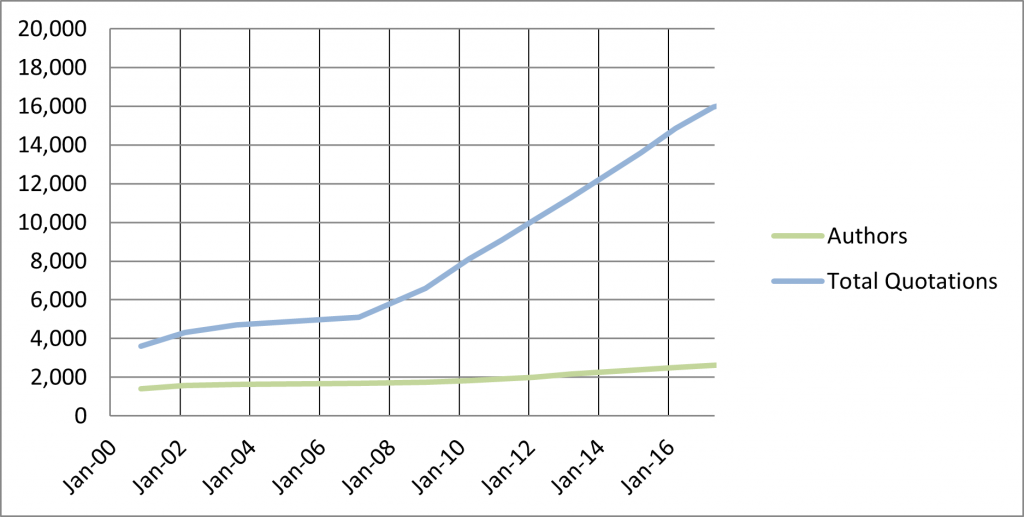Time for another “State of the WIST” post. I last ran this report in April 2017. In the intervening time there were some long periods when I was not getting much posted, though that’s largely recovered this past year or so. I try to get 5-6 quotes posted per weekday; I’m no longer posting daily images, but when a quote seems fitting for one, I’ll do it.
What’s happened over here since last time?
Some changes that took place on the WordPress site the past few years:
-
- Upgraded to the most recent versions of WordPress. Which turned out to be easier than expected (and a good excuse to get rid of some plugins I no longer need).
- Turned on secure connections (https: access). Not that there’s anything here that needs that, but site that don’t get little nasty messages on the browser, so I did.
- Lost (and haven’t yet found a good way to fix) a mobile theme that works well. WIST is still usable on phones, but, as Google is always reminding me, it’s not “optimized” for that.
- I added a Random Quote button.
- My mirroring to Google+ has gone away with that site, and I no longer mirror to Facebook — but I am mirroring to a *Diaspora site (automatically), as well as my Twitter feed.
Doing the Numbers
Let’s look at the numbers:
So continued progress.
Broken out into a graph (and normalizing the time frame):
There’s a slight decrease in slope over the past few years, but it’s nearly unnoticeable.
Note that, as always, all of these quotations are curated to some degree or another — digging out citations when possible, finding author photos, etc. No mass uploads for me.
Top Authors
Of the authors I have, who are the most quoted in WIST?
As the numbers get higher, it’s harder folk to do more than shuffle around, esp. barring I find any massive new source of quotations. While everyone’s overall numbers went up, that’s esp. more true for folk toward the top — Emerson added 41 since last time, Shakespeare 20, etc. (Lewis actually went down slightly, as I deleted some duplicate quotes I’d entered.)
Martin Luther King, Jr., is back on the board again, displacing Eric Hoffer from the Top 10.
This stat is more for curiosity’s sake than any real meaning, showing not just how prolific these folk are, but how interested I am in recording things they wanted to say.
The Top Ten Author list is shown “live” in the sidebar (“Prolific Authors”).
Top Quotations
Here are the Top 10 Most Visited Quotations Ever (with how they’ve changed since last April 2017):
- ↑ (7,786, was 5,019) John Kenneth Galbraith, “Wealth and Poverty,” speech, National Policy Committee on Pockets of Poverty (13 Dec 1963)
- – (5,979, was 4,803) Aeschylus, Agamemnon, ll. 175-183 [tr. Johnston (2007)]
- ↓ (5,926, was 5,019) Robert Frost, “The Lesson for Today,” A Witness Tree (1942)
- ↑ (5,073, was 3,552) Bertand Russell, “The Triumph of Stupidity” (10 May 1933)
- ↓ (4,882, was 4,589) John Steinbeck, Nobel prize acceptance speech (10 Dec 1962)
- ♥ (4,171, new) William Hazlitt, “On The Conduct of Life” (1822)
- ↓ (3,920, was 3,360) James Baldwin, “In Search of a Majority,” Speech, Kalamazoo College (Feb 1960)
- ↓ (3,746, was 2,960) Molly Ivins, “Get a Knife, Get a Dog, but Get Rid of Guns,” Fort Worth Star-Telegram (9 Mar 1993)
- ♥ (3,375, new) Isaac Asimov, “A Cult of Ignorance,” Newsweek (21 Jan 1980)
- ♥ (3,322, new) Arthur M. Schlesinger, Jr., “The Historian as Participant,” Daedalus (Spring 1971)
Some actual movement here, with three quotes entering the top 10 (losing a Thomas Campbell and a spurious Albert Einstein). I find this interesting, since it’s not driven anything I do, but page hits by visitors.
Over 2020, the Top 10 viewed quotes were, according to Google Analytics (albeit with a gap between March and September):
- 682 views – Rilke, Rainer Maria — Letter to Clara Rilke (1 Jan 1907)
- 661 views – Galbraith, John Kenneth — “Wealth and Poverty,” speech, National Policy Committee on Pockets of Poverty (13 Dec 1963)
- 482 views – Plato — Republic, Book 1, 347c
- 440 views – Hazlitt, William — “On the Conduct of Life” (1822)
- 393 views – Voltaire — Questions sur les miracles (1765)
- 387 views – Lamb, Charles — “The Two Races of Men,” Essays of Elia (1823)
- 359 views – Sa’adi — Poem on Humanity
- 292 views – Schlesinger, Arthur M. Jr. — “The Historian as Participant,” Daedalus (Spring 1971)
- 283 views – Asimov, Isaac — “A Cult of Ignorance,” Newsweek (21 Jan 1980)
- 275 views – Aristotle — Nichomachean Ethics (c. 350 BC)
Not surprisingly, most of the above have a graphic image / meme associated with them on their page, and many are the overall Top 10 list. Only a few, though, were on the same year list in April 2017.
Who Are You People?
The gap in Google Analytics data makes it hard to see a full snapshot, but looking at the last three months, my traffic is up from April 2017, with each day, on average, 138 visitors (vs 45), and 183 pages viewed (vs 73).
I still have 25 people who get a daily email (via FeedBurner) of WIST content
Over in social media, I’m posting to Twitter (132 followers, up from 127). As noted above, Google+ has gone away, and I’ve dropped Facebook. I have 33 contacts on my *Diaspora mirror.
I’m skipping over my Tumblr and Pinterest numbers, give that I have not been manually mirroring to those sites in a while.
Those numbers aren’t huge, by any means — but this is a labor of love, and it’s nice to see that some folk are finding it of use and/or interest.
Gender (identified in 40% of visitors), splits 54-46 female-male. For age (idenfied in 31% of visitors), the 18-24 and 25-34 cohorts are each around 25% of visitors. the 35-44, 45-54, 55-64, and 65+ cohorts all hover around 12-13% each.
Not surprisingly, the vast majority (87%) of visitors to WIST.info are flagged as one flavor or another of English-speaker. Nationally, 56% are from the US, another 8% from the UK, with India, Canada, and Australia rounding off the Top 5 (at 6, 5, and 3%).
57% of visits here over the last year used Chrome (up), 29% Safari (up), 5% Firefox (down), 4% Edge (up), 2% IE (down). 34% were Windows users (down), 24% Mac (up), 20% iOS (up), and 17% Android (up). Those last two numbers are interesting, given the “unfriendly” nature of the site for mobile users.
The Year Ahead
I don’t currently have any major plans on WIST for the coming year, but some things i do have in mind:
- Continue backfilling tags as I come across quotes that have captured my eye again. Maybe do some tag cleanup.
- Do another “are they dead yet?” sweep of the authors.
- Figure out how to better support mobile access. The way I customize the display makes finding a usable (customizable) theme difficult.
And that’s the end of the not-very-annual report for 2020. See you next year!



